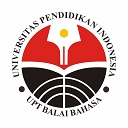The Use of Wo Tooshite/Tsuujite and Ni Watatte as Time Markers in Japanese Sentence: An Overview of Grammatical Meaning
Abstract
This study aims to determine the similarities and differences in the use of ~ wo tooshite/tsuujite and ~ ni watatte based on its’ grammatical meaning as time markers. However, eventhough both functioned as time markers, in terms of grammatical meaning, both have subtle differences. This study is a qualitative descriptive study with data taken taken from Twitter.com as the data source. After 25 data of each time markers collected, the data then analyzed based on the grammatical meaning and structures, including the word classes which come before (noun) and after (the predicate) ~ wo tooshite/tsuujite and ~ ni watatte. The results showed that the similarities of ~wo tooshite/tsuujite and ~ni watatte in terms of grammatical meaning were decided by the context of the sentence, which represent the period of the activity and the phenomena of the situation occured. On the other hand, the difference between ~wo tooshite/tsuujite and ~ni watatte is that ~wo tooshite/tsuujite is used when mentioning natural phenomena that occur repeatedly and continuously, while ~ni watatte emphasizes the duration of the activity. Moreover, ~ni watatte is used to express a negative state because of the nuance that the time is very long, while to express a continuing state of hope such as ‘can enjoy all year round’, both time markers can be used.
Keywords
Full Text:
PDFReferences
Agustin, Y. (2015). Penguasaan Tata Bahasa dan Berpikir Logik Serta Kemampuan Menulis Artikel Ilmiah [Mastery of Grammar and Logical Thinking and the Ability to Write Scientific Articles]. Faktor Jurnal Ilmiah Kependidikan, II(2), 123–132.
Ajia Gakusei Bunka Kyoukai. (1997). Kanzen Masutaa 2kyuu Nihongo Nouryoku Shiken Bunpou Mondai Taisaku [Complete Master Level 2 Japanese Language Proficiency Test Grammar Question Preparation]. Tokyo: 3A Corporation.
Chaer, A. (2013). Pengantar Semantik Bahasa Indonesia [Introduction to Indonesian Semantics]. Bandung: Rineka Cipta.
Etsuko, T., Miyamoto, J., & Masako, W. (2007). Donna Toki Dou Tsukau Nihongo Hyougen Bunkei Jiten [Japanese Expression Sentence Pattern to Use When and How]. Tokyo: Aruku.
Guruupu Jamashii. (1998). Nihongo Bunkei Jiten [Japanese Grammar Dictionary]. Tokyo: Kuroshio Shuppan.
Hanazono, S. (2003). “N ni watatte” ni tsuite [About “ N ni watatte”]. Bulletin of Japanese Language Center for International Students, 29, 133–144. Retieved from http://hdl.handle.net/10108/20959
Hanazono, S. (2004). “N wo tooshite” to “N ni toojite” [“N wo tooshite” and “N ni toojite”]. Bulletin of Japanese Language Center for International Students, 30, 17–31. Retrieved from http://hdl.handle.net/10108/20968
Iori, I., Takanashi, S., Nakanishi, K., & Yamada, T. (2001). Chuujoukyuu Wo Oshieru Hito No Tame No Nihongo Bunpo Handobukku [Japanese Grammar Handbook for Intermediate and Advanced Teachers]. Tokyo: 3A Corporation.
Kaufmann, M. (2017). What ‘may’and ‘must’may be in Japanese. Japanese/Korean Linguistics, 24, 103-126.
Larm, L. (2018). On the teaching of Japanese epistemic and evidential markers: theoretical considerations and practical applications. In International Perspectives on Translation, Education and Innovation in Japanese and Korean Societies (pp. 161-170). Springer, Cham.
Morita, E., & Kim, K. H. (2022). Revisiting grammatical particles from an interactional perspective: The case of the so-called ‘subject’and ‘topic’particles as pragmatic markers in Japanese and Korean: An introduction. Journal of Pragmatics, 188, 31-38.
Muhammad. (2019). Metode Penelitian Bahasa [Language Research Methods]. Yogyakarta: Ar-Ruzz Media.
Obe, R., & Haberland, H. (2018). Involvement and Attitude in Japanese Discourse: Interactive Markers. Nordic Journal of Linguistics, 41(1), 117.
Oyanagi, N. (2002). New Approach Japanese Pre-Advanced Coyrse. Tokyo: Ajia Gobun Shuppan.
Shigeru, M. (2009). Imi-ron no Kihontekiwakugumi Ni Tsuite [The basic framework of semantics]. Toyamadaigaku Sugitani Kyanpasu Ippan Kyōiku, 37, 79–81. https://doi.org/info:doi/10.15099/00002932
Stanlaw, J. (2021). Using English as identity markers in Japanese popular music: J-pop and beyond. In English in East and South Asia (pp. 198-211). Routledge.
Sudjianto, & Dahidi, A. (2007). Pengantar Linguistik Bahasa Jepang [Introduction to Japanese Linguistics]. Jakarta: Keisant Blanc.
Uchiyama, K. (n.d.). “Ichinen ni watatte” to “ichinen ni tooshite” [“Ichinen ni watatte” and “ichinen ni tooshite”]. Retrieved from http://nifongo.style.coocan.jp/058.htm
Verhaar, J. W. M. (2016). Asas-asas Linguistik Umum [Fundamentals of General Linguistics]. Yogyakarta: Gadjah Mada University Press.
Wigiati. (2012). Kalimat Dalam Bahasa Indonesia [Sentences in Indonesian]. Retrieved from http://pustaka.unpad.ac.id/wp-content/uploads/2010/03/kalimat_dalam_bahasa_indonesia.pdf
DOI: https://doi.org/10.17509/japanedu.v7i1.44397
Refbacks
- There are currently no refbacks.
Copyright (c) 2022 JAPANEDU: Jurnal Pendidikan dan Pengajaran Bahasa Jepang

This work is licensed under a Creative Commons Attribution-ShareAlike 4.0 International License.
 Published by:
Published by: Department of Japanese Language Education, Faculty of Language and Literature Education
Universitas Pendidikan Indonesia
 Online ISSN: Online ISSN:2528-5548 |

JAPANEDU: Jurnal Pendidikan dan Pengajaran Bahasa Jepang (e-ISSN:2528-5548) lisenced under a Creative Commons Attribution-ShareAlike 4.0 Internasional (CC BY-SA 4.0)


